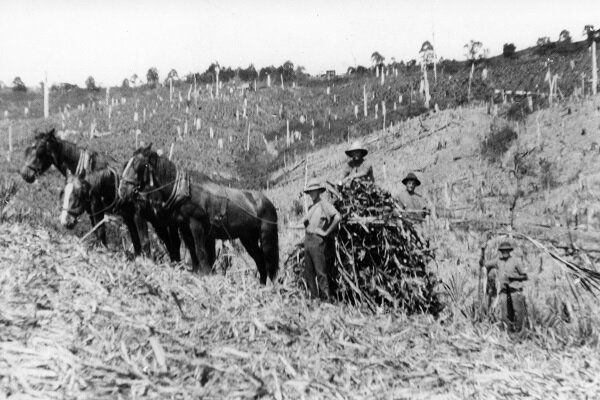Mapleton was a very different landscape than it is today
In earlier times the Mapleton district was a very different landscape than it is today. The area was first traversed by European explorers in the 1840s. It was covered in lush rainforest and a lot of massive trees, including Red Cedar, White Beech, Bunya and Hoop Pine.
Thick undergrowth and vines made the area difficult for early explorers and timber getters to navigate. The scrub, as the rainforests were known, covered much of the Blackall Range including the Mapleton region.
The lure of timber brought the first pioneers during the 1880s and large quantities of trees were felled by axe-men using spring boards. In late 1880s, David Smith from Redland Bay sent his two sons to the region in search of suitable land for fruit growing.
The North Coast Rail line had only reached as far as Caboolture at that stage, so they took a Cobb and Co. Coach from Caboolture to Nambour.
The coach and passengers stayed overnight at Cobbs Camp (now Woombye) then continued on by coach to Nambour.
In 1889 the two brothers, 20 year old Thomas and 21 year old William Smith, walked west from Nambour carrying heavy swags.
There were no tracks from Nambour, only a trail to Dulong.Timber getters James Stark from Highworth and J Murtagh from Dulong were the only pioneer settlers in that region.
Just past Highworth, the Smith brothers encountered thick thorny scrub.
It took two days to reach the range and they liked what they saw, so returned to Nambour for supplies.
They purchased a tent, axes, brush hooks and suitable provisions, which they carried on their backs while cutting a pathway through the rainforest scrub using axes and brush hooks.
They pegged out their selected block, which had not been surveyed, and staked their claim adjacent to Mapleton Falls.
They weren’t to know at the time, but these two young men were founding a new settlement.
Later when drought occurred, the swampy grounds near the falls assisted when water became scarce.
William Smith lodged an application for an agricultural farm on October 30, 1889.
He later forfeited that selection as it was not the land he had expected and later, in 1890, lodged a claim for a more fertile spot on the eastern edge of the Range.
Thomas Smith selected a block at Mapleton on November 15, 1889.
He paid a deposit for the 120 acre holding with the provision that the balance was to be paid off over 10 years and improvements made to the block.
There was no grassland to keep livestock, and the young settlers faced hard days and nights of laborious work to clear enough land for some pasture. By 1891 the brothers had built a two roomed slab hut with a shingle roof and flagstone floor.
They cleared enough land for pasture and planted bananas and orange trees, as well as other crops. Once the hut was completed, their sister Amy came to the range to assist with domestic duties.
A drought from 1891 to 1892 saw all surface water dry up in every creek. They feared failure, but Thomas noticed a patch of moist ground near a stand of gum trees.He set to work with his brother and dug a 20 metre deep well.
They were renowned for their hard work – while waiting for their crops to grow the brothers built roads down the range and did timber getting. At night they would hang a lantern close by to plant their strawberries and other crops. They planted five different varieties of bananas and after 12 months they were ready for market.
The Smith brothers purchased five pack horses at $3 each (a substantial amount of money for the time) to bring their bananas down the steep range to Woombye to meet the newly opened rail line and load up their goods for market.
The return trip by pack horse took them 12 hours from Woombye.The extension of the main railway system reached Nambour in 1891, which opened up the district to further settlement.
Seedlings planted by the Smiths produced the first citrus crop by 1892.Mapleton quickly became a leading citrus producing area. Once the road to Palmwoods was complete the harvested fruit was packed into wooden cases and transported by horse-drawn wagon down the steep and narrow Range Road to Palmwoods Railway Station.
At the turn of the 20th century, land clearing by settlers had made way for sugar cane, dairy farming, crops and pasture.Prior to motorised transport, many early roads began as tracks carved out of the forests with bullock teams. Dulong Lookout was once close to the original road leading from the major township of Nambour to Mapleton which went straight up the Dulong Range and over Dalzell’s Pinch.
James Allen Dalzell had selected land in 1882 near where the lookout is situated. Transport problems such as the Dalzell Pinches, in the Dulong Range, proved a stumbling block to settlers for many years trying to manoeuvre bullock teams, haul timber and later sugar cane down to Nambour.
Forms of transport including slides were used behind horses as well as pack horses throughout this district.Next week we will continue the story of Mapleton and its development into the 20th century.
Thanks to Sunshine Coast Council’s Heritage Library Officers for the words and Picture Sunshine Coast for the images.







